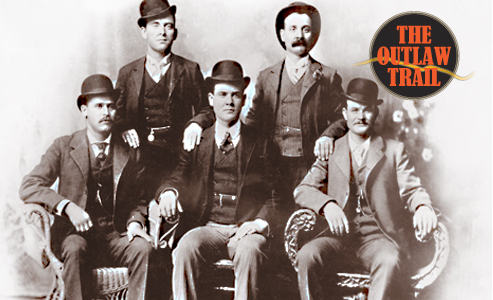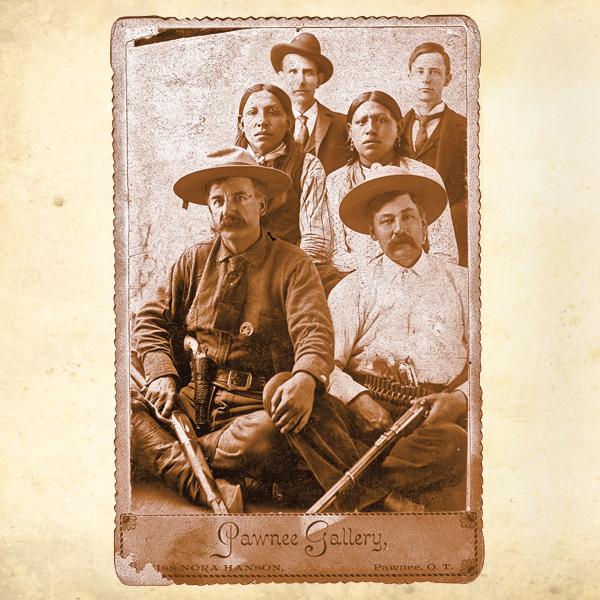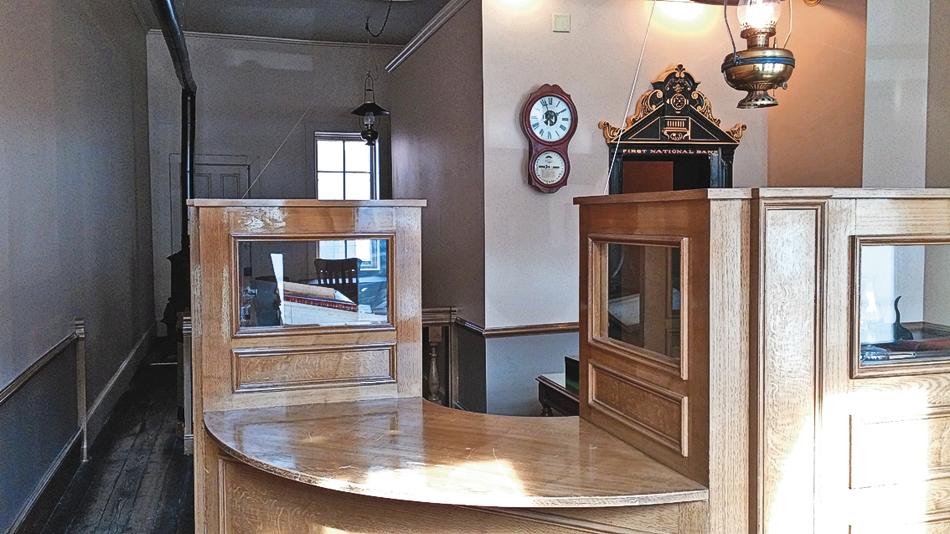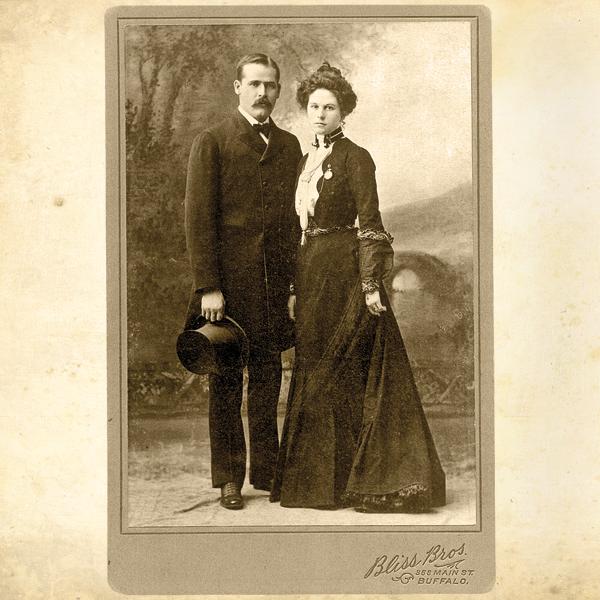 The two riders pounded the trails and roads of eastern Utah on that late April afternoon in 1897. They kept up a quick pace—had to, since they were being trailed by a bunch of guys armed with guns and questions.
The two riders pounded the trails and roads of eastern Utah on that late April afternoon in 1897. They kept up a quick pace—had to, since they were being trailed by a bunch of guys armed with guns and questions.
Questions like “Where do you think you’re going with that money you just stole at Castle Gate?”
The posse wouldn’t get the answers they were looking for; outlaws Butch Cassidy and Elzy Lay made sure of that.
They had fresh mounts and provisions already stashed at locations on the trail.
Butch and Elzy were headed about 120 miles southwest, to the elevated plateau called Robber’s Roost, an outlaw hideout where they and their nearly $9,000 take would be safe from the law.
The boys had just traveled part of the Outlaw Trail. It was a trail they knew well, having ridden it countless times over the years.
The West was—and is, to a large extent—filled with the trails followed by the pioneers, settlers, bandits and lawmen of old. And it’s still possible to visit many of those places, to see what those guys saw, to experience what they experienced (hopefully without the running gunfights). And there are some pretty neat museums and other institutions to check out as well.
Let’s mount up and hit the trails.
THE REAL OUTLAW TRAIL
The Outlaw Trail wasn’t really one specific trail, but a series of hideouts that ran from Montana through Wyoming, Colorado, Utah, New Mexico, Arizona, Texas and even into Mexico.
The best-known hideouts included the aforementioned Robber’s Roost in southeast Utah. Then there was Brown’s Hole/Park, a tough Colorado canyon area near the Wyoming and Utah borders. But perhaps the best known was Hole-In-The-Wall, the Wyoming valley surrounded by imposing rock formations and few entrances.
The three areas have been set aside by the federal government, protecting them from development. So with some effort, you can still see them as the Wild Bunch did.
And Castle Gate? Where Butch and Elzy pulled the robbery? It’s a ghost town, abandoned more than 40 years ago.
Off the Trail
The nearest town to Castle Gate is Helper, about 120 miles southeast of Salt Lake City and seven miles northwest of Price. It’s where the Wild Bunch stayed while they were planning the holdup. Its Western Mining and Railroad Museum has a treasure-trove of history. WMRRM.com
When in northeast Wyoming, check out the town of Buffalo (the Wild Bunch did on many occasions), about 70 miles north of Hole-In-The-Wall. The Jim Gatchell Museum has much on the local and infamous Johnson.
Put Your Boots Up!
Butch and the boys knew Nine Mile Canyon, about six miles southeast of Price, Utah. It’s actually about 40 miles long. Ancient petroglyphs adorn the ruggedly high walls. And Cassidy pal Matt Warner also placed his name in bold letters on the rocks. CastleCountry.com
WILD BILL: ROCK CREEK STATION TO DEADWOOD
Wild Bill Hickok’s story and legend ended in Deadwood in 1876. But the whole thing got started 15 years before and 580 miles to the southeast.
It was at a place called Rock Creek Station, a stop-off on the Oregon Trail and Pony Express/Overland Stage route. Wild Bill was working there in the late afternoon of July 12, 1861, when the former owner of the property showed up. David McCanles was ticked because the new owners were behind on their payments.
Just exactly what happened is unclear. But tempers got out of hand; McCanles and two of his men were killed.
It was Hickok’s first brush with notoriety but certainly not the last, with the finale at that saloon card table at the appropriately named Deadwood.
Off the Trail
Rock Creek Station—about 67 miles southwest of Lincoln, Nebraska—is now a state park, with reconstructed buildings and many artifacts for viewing. Nearby are some of the most pristine trail ruts anywhere on the Oregon Trail. NebraskaStateParks.ReserveAmerica.com
In Deadwood, the Adams Museum is one of the top institutions of its kind in the West, with many items dating back to the time of Wild Bill and Calamity Jane. DeadwoodHistory.com
Put Your Boots Up
Famed Deadwood lawman Seth Bullock and his partner Sol Starr opened the Bullock Hotel in 1896. The place is open for business today, with 28 rooms, a restaurant and a casino. HistoricBullock.com
EARPS AND McLAURYS: FROM IOWA TO TOMBSTONE
One of the great ironies of the gunfight near the O.K. Corral is that the Earps and the McLaurys spent their formative years in Iowa (although about 100 miles apart).
In November 1873, 24-year-old Frank McLaury—still living at home in Buchanan County—got into a fight with a neighbor and was charged with assault and battery. Frank was found guilty and did 30 days in jail. When he got out, Frank and younger brother Tom headed southwest.
After a stopover in Texas, the brothers ended up in Arizona. That didn’t work out so well.
Off the Trail
Pella’s Historical Village and Vermeer Windmill (about 43 miles southeast of Des Moines) includes the Earp homestead, the place where Wyatt lived off and on from age 2 until 16 or so. PellaHistorical.org
Tom and Frank McLaury spent some time in Fort Worth, Texas, where their older brother Will practiced law. The stock- yards museum features numerous exhibits on the history of the city “Where the West Begins.” FortWorthStockyards.org
And Tombstone? Well, the entire town is history, isn’t it? Including Boot Hill, where Tom and Frank McLaury (and fellow combatant Billy Clanton) are buried. BoothillGraves.com
Put Your Boots Up
The legendary Bird Cage Theater opened its doors on Christmas 1881—right in the middle of the Cowboy/Earp problems. The place provided music and dancing and booze and more. It’s still open for visitors, a showcase of Tombstone history and legend.TombstoneBirdcage.com
BILLY AND PAT: FROM LINCOLN TO FORT SUMNER
Billy the Kid’s last journey started in the early evening of April 28, 1881. That was when he killed two of his jailers and escaped from the Lincoln County Jail—he wasn’t too eager to be hanged for murdering a Lincoln County sheriff and deputy. He headed for familiar ground, Fort Sumner, about 90 miles northeast (by the current highways, about 140 miles), where he had many friends.
In mid-July, Sheriff Pat Garrett and two deputies made their way to Fort Sumner. The final act, in the bedroom of Pete Maxwell, was something of an accident. Billy and Garrett never expected to run into each other there. And Garrett initially wasn’t sure it was the Kid who’d taken the fatal bullet.
Garrett left the place in triumph. Billy stayed forever. Both became legends.
Off the Trail
Lincoln (60 miles west of Roswell) is one of the most authentic Old West towns anyplace. Check out the old courthouse where the Kid was held and killed the two jailers. LincolnCountyNM.org
And at Fort Sumner (158 miles southeast of Albuquerque), the Old Fort Sumner Museum has a number of Billy-related items. And just behind it is the fenced-in gravestone of Billy and two of his gang members. FortSumnerChamber.com
Put Your Boots Up
Just across the street from the old courthouse is the Wortley Hotel. Deputy Bob Olinger was eating there when Billy the Kid made his escape—it was Olinger’s last meal, since the Kid killed him in the process of breaking out. It is still a wonder-ful hotel and restaurant. WortleyHotel.com
TEXAS RANGERS AND THE JESSIE EVANS GANG: FORT DAVIS TO PRESIDIO DEL NORTE
Jessie Evans was a hard case who fought against Billy the Kid and the Regulators in the Lincoln County War and managed to put a few notches on his pistol. When that conflict ended, he moved his operations into Texas.
In-mid May 1880, the Evans Gang hit several places around Fort Davis. They escaped northeast about 90 miles to Fort Stockton, but the law followed and they headed about 100 miles southwest to Presidio Del Norte, just across the Rio Grande. The Texas Rangers followed.
The lawmen ran into the fugitives about 19 miles northeast of Presidio del Norte on July 3. A running gun battle started, leaving one dead and one wounded on each side before Evans and company surrendered.
By the way, for all his misdeeds, Jessie Evans spent 18 months in prison before escaping and disappearing from history.
Off the Trail
Fort Davis (approximately 200 miles southeast of El Paso) is home to one of the best-preserved Indian Wars military posts, dating back to 1854. A fair amount of it looks just as it did in Jessie Evans’ day. NPS.gov
Presidio Del Norte is today’s Ojinaga, Chihuahua. Its twin, Presidio, Texas, is the gateway to the amazing Big Bend region with natural wonders and splendors unseen anywhere else.VisitBigBend.com
Put Your Boots Up
About 21 miles southwest of Fort Davis is the town of Marfa. See the historic courthouse and the old jail across the street. VisitMarfa.com
HECK THOMAS AND BILL DOOLIN: INGALLS TO LAWSON
September 1, 1893. A 14-man posse tried to sneak up on the Bill Doolin Gang in Ingalls, about 10 miles east of Stillwater, Oklahoma. It went bad; three officers were killed and almost the entire gang escaped. But the heat was on. Over the next three years, several of the outlaws bit the dust.
Doolin was captured in Arkansas and jailed in the territorial capital, Guthrie, in January 1896, but he broke out that July and made his way to the town of Lawson—now called Quay—about 55 miles northwest.
The law went after him. Deputy Marshal Heck Thomas and nine men ambushed Doolin near his father-in-law’s house, leaving him dead in the road.
Off the Trail
Ingalls is basically a ghost town, with the remains of a few of the old buildings still standing. You can pretty much imagine the Doolins shooting it out with the law.
Guthrie is located just 30 miles north of Oklahoma City. Check out the Oklahoma Territorial Museum for exhibits, artifacts and more. And nearby, in the Summit View Cemetery, Bill Doolin and a few of his outlaw pals rest forever. OKTerritorialMuseum.org / CityOfGuthrie.itlnet.net
Put Your Boots Up
Gages Steakhouse is located in the basement of historic Sand Plum Building of the Victor Block built in 1893 in Guthrie’s Historic District. It is a great place to grab a drink or have a big steak with all the amenities of the Old and modern West. GagesSteakhouse.com
BLACK BART: SISKIYOU TRAIL FROM SAN FRANCISCO TO THE WILLAMETTE VALLEY
Between the middle of 1875 and the fall of 1883, Charles E. Boles—calling him-self Black Bart in a poem he left at one holdup site—pulled more than two dozen stagecoach jobs, all in northern California and southern Oregon. He favored the rugged Siskiyou Trail (now I-5), which covered the mountainous region between Portland and San Francisco.
Witnesses called him dignified, with a booming voice and polite manner. He was always on foot. And what his victims didn’t know—his shotgun was always empty.
In November 1883, Bart dropped a handkerchief at a robbery outside Copperopolis, California. The hankie had a laundry mark on it which detectives traced back to San Francisco. They caught Boles, who pleaded guilty to just the last stickup. He did four years at San Quentin and then disappeared.
But the legend of the greatest stage robber in U.S. history remains.
Off the Trail
The historic mining town of Copperopolis, California, is still around and celebrates its heritage. Four buildings are on the National Register. CalaverasHistory.org
The old Siskiyou Trail passes through cities like Medford, Oregon. The Southern Oregon Historical Society has done an excellent job of preserving buildings in that city as well as in Ashland and Jacksonville. SOHS.org
Put Your Boots Up
Stop in at the town of Yreka, California, right near the Oregon border and on the old Siskiyou Trail. The county museum includes five historic buildings, one dating back to 1856. It has much related to the area’s gold-prospecting roots. SiskiyouCountyHistoricalSociety.org
EVANS AND SONTAG, ROBBING THE RAILS: VISALIA TO FOLSOM
Chris Evans and John Sontag made a rep for robbing trains in central California between 1889 and 1892.
In August 1892 railroad detective Will Smith and Tulare County Deputy Sheriff George Witty searched Evans’ Visalia home (around 190 miles north of L.A.), looking for evidence of a train stickup.
Evans and Sontag, both armed, confronted the pair. The lawmen ran; the outlaws opened fire. Both Smith and Witty were hurt before the shooting ended.
Evans and Sontag managed to stay away from the law for about 10 months. Sontag was fatally wounded in a shootout on June 11, 1893; Evans lost an eye and an arm before being captured.
Chris Evans spent 17 years at Folsom Prison, about 20 miles northeast of Sacramento.
Off the Trail
The Tulare County Museum in Visalia has a large collection of exhibits and artifacts from the pioneer era. TulareCountyHistoricalSociety.org
Folsom Prison is still a working facility. But the prison museum, located in a historic house on the grounds, offers a view of the history of the big house and its inmates. FolsomPrisionMuseum.org
Put Your Boots Up
Evans and Sontag made their way through the town of Merced, about midway between Folsom and Visalia. They probably saw the courthouse (but not a courtroom), built in 1875. It now houses a wonderful museum that chronicles the history of the region known for its agricultural and commerce foundation. MercedMuseum.org
APACHE KID: SAN CARLOS AGENCY TO YUMA PRISON
Gila County (AZ) Sheriff Glenn Reynolds and a deputy were taking nine prisoners from the Globe area to Yuma Prison, about 260 miles away. It was a tough task, made tougher by one of the convicts—the wiley Apache Kid.
The journey to justice began via stagecoach on November 1, 1889. The captives got out to walk at a steep section of road. They took advantage of that and attacked the guards. Reynolds and the deputy were shot to death.
All of the Apaches were captured or killed in short order except the Apache Kid, who continued his one-man war against authorities, whites and Mexicans throughout the region. He supposedly was killed in Mexico in 1890.
Off the Trail
The San Carlos Apache Cultural Center is in Peridot, about 20 miles east of Globe, Arizona. It has much on the history and culture of the tribe, especially in that region. SanCarlosApache.com
The Gila County Historical Museum in Globe features a number of exhibits on local heritage—including the infamous Pleasant Valley War feud. GilaHistorical.com
And even if the Apache Kid didn’t make it to Yuma, you can visit the territorial prison. It’s now a state park. AZStateParks.com
Put Your Boots Up
It’s likely that the Kid and his captors traveled through what is now the Sonoran Desert National Monument. It’s more than 487,000 acres of incredible landscape with three mountain ranges, a huge saguaro cactus forest and numerous historic trails. BLM.gov
THE KANSAS COWTOWNS: ABILENE TO DODGE CITY
Abilene and Dodge City, Kansas. Separated by about 185 miles; forever linked by Texas cattle drives and the men who hit those towns.
Among those were the British-born Thompson brothers, Ben and Billy, gamblers by profession and gun handlers by practice.
They started off in Abilene. The Thompsons partly owned and ran a watering hole known as the Bull’s Head; it was outside that establishment where Marshal Wild Bill Hickok did his last two killings in 1871.
Following some interludes in other Kansas and Texas burgs, the brothers hit Dodge City in 1877, looking to make easy money at the tables. At one point, Ben playfully threatened to shoot entertainer Eddie Foy; Bat Masterson took his gun away before anything bad happened.
The cowtowns slowed down after that. The Thompsons relocated to Texas, where Ben was murdered in 1884 and Billy died in bed 13 years later.
Off the Trail
Old Abilene Town has managed to save and restore a number of buildings dating back to the pioneer days. Combined with The Heritage Center, that’s three different museums. OldAbileneTown.webs.com / HeritageCenterDK.com
At the other end of the line, Dodge City features its Boot Hill Museum and Boot Hill Cemetery. You’ve heard of those, no doubt. BootHill.org
Put Your Boots Up
If you head down the trail from Abilene to Dodge, you’ll run into the town of Great Bend, which has its own Old West history. The Barton County Historical Society Museum and Village features several restored buildings. VisitGreatBend.com
THE JAMES-YOUNGER GANG OUTSIDE ITS COMFORT ZONE: KANSAS CITY TO NORTHFIELD
The James-Younger Gang, based mostly in northwest Missouri (modern suburban Kansas City, Missouri), ventured to various locales to acquire cash.
In September 1876 they traveled 400 miles northward, to Northfield, Minnesota, 45 miles south of Minneapolis. It’s not exactly clear why they went up there. The outlaws probably thought the First National Bank would be an easy job.
Oops. Townsmen fought back hard and then chased the outlaws through the countryside. Only Jesse and Frank James managed to get back home to Missouri. Three of the outlaws were killed, and the Younger brothers did time at state pen.
Jesse and Frank never did really recapture the days of glory (unless you want to count Jesse’s death in 1882 as glorious).
Off the Trail
A number of Jesse James sites are within 60 miles of Kansas City. His Farm and Museum is in Kearney, about 25 miles north. Another 35 miles takes you to St. Joseph, the Jesse James Farm, the Pony Express Museum, and the house where Jesse was gunned down by Bob Ford. JesseJames.orgPonyExpress.org
In Northfield, the First National Bank is a museum. And each September, the town holds The Defeat of Jesse James Days, with re-enactments and activities honoring the citizens (including two who died) battling the outlaws. NorthfieldHistory.org
Put Your Boots Up
The James-Younger Gang originally planned a robbery for the town of Mankato, almost 60 miles southwest of Northfield. The Blue Earth County Historical Society is something to check out, with a great museum and the R.D. Hubbard House, which dates back to 1871. BechsHistory.com
THE LIFE OF JOHN WESLEY HARDIN: FROM BONHAM TO EL PASO
John Wesley Hardin got a relatively innocent start in 1853, born outside of Bonham, Texas, about 70 miles northeast of Dallas. It probably was the last innocent time of his life.
Over the next 21 years, he may have killed 40 men.
Wes was finally captured and jailed in 1877. And after he got out, he made his way to El Paso. Hardin went bad, again, and ticked off folks. At the top of the list—a constable and hard case named John Selman.
Old John gunned Hardin down from behind in the Acme Saloon on August 19, 1895. El Paso was 700 miles and much violence away from Bonham.
Off the Trail
Bonham doesn’t necessarily like to claim Hardin. But they’ve got a great institution in the Fannin County Museum of History, located in a 1900 railroad depot. FanninCountyHistory.org
As for El Paso, well, you can visit Wes himself at the Concordia Cemetery, one of the biggest tourist draws in the area. And not far away is the grave of Hardin’s killer, John Selman, who took a fatal bullet himself eight months after he dispatched the famed gunfighter. ConcordiaCemetery.com
Put Your Boots Up
Reportedly, Wes considered being a lawyer at San Angelo, about midway between Bonham and El Paso. The city’s Old Town has several restored, historical buildings dating back to the 1880s. It’s a glimpse of what things looked like during Hardin’s time. VisitSanAngelo.org
Mark Boardman is True West’s features editor and the monthly columnist of “Investigating History.”
Photo Gallery
– True West Archives –
– J.A. Kumpf/Courtesy Library of Congress –
– Utah Office of Tourism –
– California State Library –
– True West Archives/Courtesy Visit El Paso –
– Courtesy True West Archives/Pella Historical Society & Museums –
– Courtesy Carol M. Highsmith, Library of Congress –
– True West Archives –
– Courtesy Robert G. McCubbin Collection –
– True West Archives/Courtesy Dodge City CVB –
– Courtesy Paul Northrop/Texas Ranger Hall of Fame and Museum –
– Courtesy Northfield Historical Society –
– Courtesy Library of Congress –
– Courtesy Robert G. McCubbin Collection –
These members of the Wild Bunch enjoyed their 1901 holiday in the Texas cowtown, a comfortable respite from their wilderness hideouts in the canyon lands of southeastern Utah (next slide).
– Courtesy Robert G. McCubbin Collection –
– Courtesy Wortley Hotel/True West Archives/Mr. and Mrs. James Joplin –
– Courtesy South Dakota Tourism/Robert G. McCubbin Collection –
– Yuma Visitors Bureau-VisitYuma.com –

























